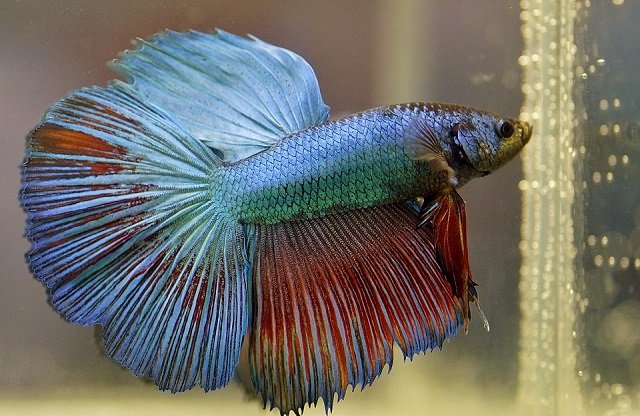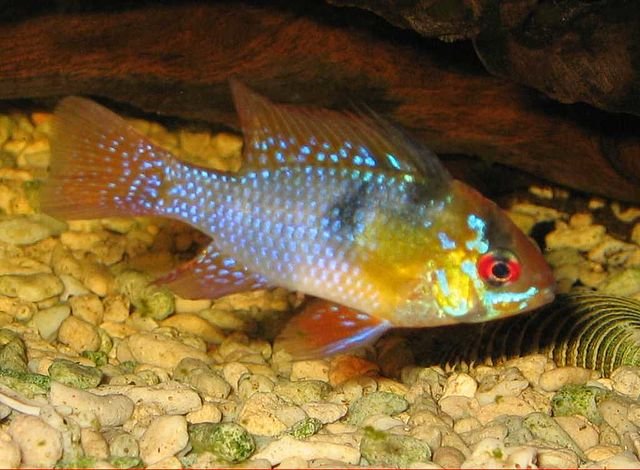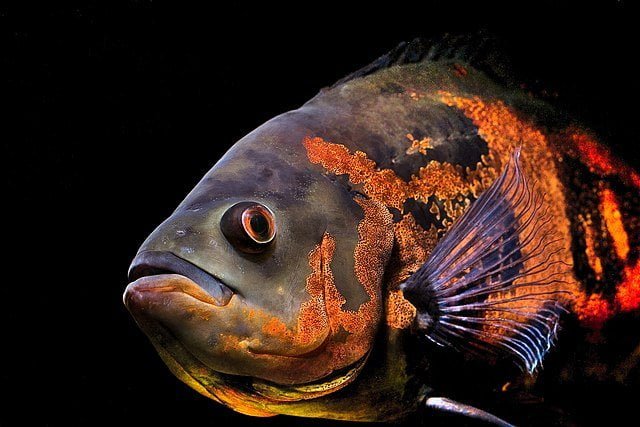
Have you ever seen a fish with vibrant colors and a surprising personality? If so, you may have encountered the Oscar fish (Astronotus ocellatus). These captivating cichlids are popular among aquarists for their beauty, behavior, and intelligence, as they can recognize their owner. But before bringing one home, it is essential to understand their needs and requirements.
Apart from their significance in the ornamental industry, the Oscar fish is bred using aquaculture techniques for the production of meat for human consumption in countries like Brazil and Peru. Even though its aquaculture is still in its early stages, its hardiness and market demand augur great potential for this activity.
This guide will walk you through everything you need to know about the Oscar fish (Astronotus ocellatus), from its origins and diverse varieties to its specific care requirements, diet, breeding, and compatibility with other fish. Whether you are a seasoned aquarist or a beginner looking to venture into the fascinating world of Oscars, this article will provide the essential knowledge to ensure a thriving and rewarding experience.
Key takeaways
- 1 Key takeaways
- 2 Taxonomy of Oscar Fish
- 3 Origin and habitat of the Oscar Fish
- 4 Physical characteristics
- 5 Types of Oscar Fish
- 6 Oscar fish care
- 7 Feeding Oscar fish
- 8 How do Oscar fish reproduce?
- 9 Common diseases
- 10 Compatibility with other fish
- 11 Tips for keeping Oscar fish healthy
- 12 Where to buy Oscar fish and supplies
- 13 The Oscar fish as an invasive species: An aquarist’s responsibility
- 14 Conclusion
- 15 Oscar Fish Frequently Asked Questions (FAQ)
- 16 References
- 17 Entradas relacionadas:
- The well-being of an Oscar fish is directly dependent on the size of its aquarium. An absolute minimum of 55 gallons (approximately 200 liters) is required for a single specimen, with over 75 gallons (approximately 300 liters) needed for a pair.
- Given the Oscar’s nature as a large and voracious eater, it produces a significant amount of waste. Therefore, a robust filtration system is not merely a recommendation but a necessity to maintain optimal water quality.
- The key to a healthy Oscar with vibrant colors is a diverse diet. This should be based on high-quality cichlid pellets, supplemented with live or frozen foods and vegetable matter. Proper nutrition serves as the first line of defense against common diseases.
- The Oscar is an intelligent fish with a distinct personality, capable of interacting with its keeper. However, this intelligence is accompanied by strong territoriality.
- Keeping an Oscar is a long-term commitment (10-15 years) that demands constant monitoring of its health and behavior. Furthermore, it entails an ecological responsibility: due to their high adaptability, they must never be released into non-native habitats, where they can become an invasive species detrimental to local ecosystems.
Taxonomy of Oscar Fish
Kingdom: Animalia
Phylum: Chordata
Class: Actinopterygii
Order: Perciformes
Family: Cichlidae
Genus: Astronotus
Species: Astronotus ocellatus
Spanish Name: Pez Oscar, acarahuazú, copaneca.
English Name: Oscar Fish, Tiger Oscar, Oscar Cichlid, Marble Cichlid, or Velvet Cichlid.
Origin and habitat of the Oscar Fish
The Oscar fish, also known as Astronotus ocellatus, is a freshwater cichlid native to South America. It is mainly found in the Amazon basin, in countries such as Brazil, Peru, and Colombia. It prefers warm and calm waters, with abundant vegetation and submerged logs.
Oscar fish are resilient and have adapted to a wide range of water conditions, making them suitable for aquariums; however, due to unwanted introductions, wild populations have developed in China, Australia, and the USA.
Physical characteristics
The Oscar fish is a large fish, with a robust and elongated body. It can reach up to 30 cm in length, weigh up to 1.5 kg, and live between 10 and 15 years depending on the care provided. Its coloration varies, but it generally has an orange background with dark spots and a black ocellus on the caudal fin.
The wild-type Astronotus ocellatus has a black body with bright orange/red stripes and black eyes. In contrast, the albino variant features a white body with similar bright orange/red stripes but has pink/orange eyes (Wang et al., 2022). In contrast, juveniles display wavy, banded stripes of white and orange and have spotted heads.
Stay Always Informed
Join our communities to instantly receive the most important news, reports, and analysis from the aquaculture industry.
Male Oscar fish are usually larger and more colorful than females; however, there is no clear sexual differentiation at first glance.
Types of Oscar Fish
Oscar fish are available in a variety of color forms, each with its unique charm and appeal. From classic Tiger Oscars to stunning albino varieties, here are some of the most popular types of Oscar fish available to aquarists.
Tiger Oscar
The Tiger Oscar is perhaps the most iconic and recognizable type of Oscar fish. Known for its bold black stripes and vibrant orange, red, and yellow colors, the Tiger Oscar is a favorite among aquarists for its striking appearance and attractive personality.
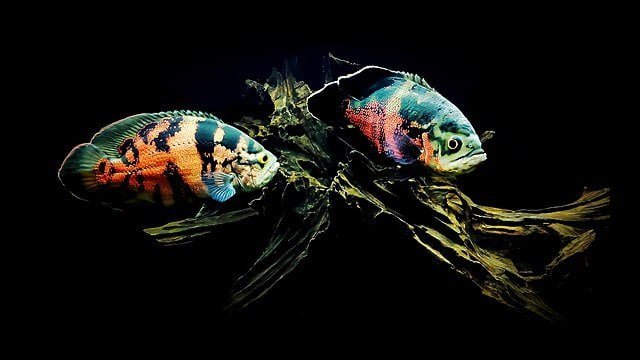
Albino Oscar
The Albino Oscar is an impressive variety known for its creamy white body and bright red eyes. With its unique coloration and playful behavior, Albino Oscars are a captivating addition to any freshwater aquarium.
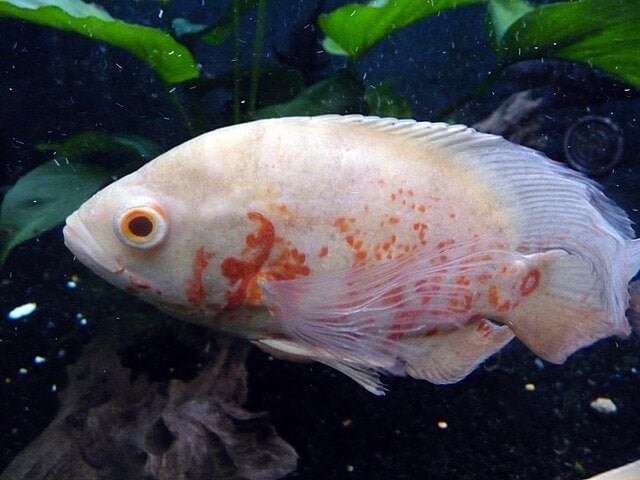
Red Oscar
The Red Oscar, as its name suggests, is characterized by its vibrant red color. With its intense hues and striking markings, Red Oscars are sure to stand out in any aquarium.

Wild Type Oscar
The Wild Type Oscar displays a more subdued coloration, with shades of green, brown, and black. While not as flashy as some of the other varieties, Wild Type Oscars have a natural beauty and elegance that appeal to many aquarists.
Oscar fish care
Aquarium size
Oscars require a spacious aquarium. For a single fish, a minimum of 200 liters (55 gallons) is recommended, while for a pair, 300 liters (75 gallons or more) is ideal. The tank should be equipped with a sturdy lid to prevent escapes, as Oscar fish are known to be excellent jumpers.
On the other hand, research by Dopeikar et al. (2021) and Dopeikar et al. (2024) reports that the use of red-colored tanks is more effective than other colors for breeding Astronotus ocellatus, in terms of growth, hematological, biochemical, and stress factors, which may be due to a greater and better physiological adaptation of the fish to this color.
Water parameters
As I previously explained, Oscar fish are resilient to variations in water quality. The following table presents the basic water parameters required for the proper rearing of the Oscar fish.
Esmaeili et al. (2025) concluded that the optimal temperature for the Oscar to achieve the best growth performance, immune response, and health status is between 22 and 27 °C. However, Rocha (2025) reports that the cichlid does not tolerate large temperature fluctuations, with its activity decreasing below 15°C and death occurring below 10°C. Furthermore, Zare et al. (2024b) suggest that an 8-hour photoperiod (8L:16D) is optimal for this species.
Table 01. Water quality parameters for rearing Oscar fish.
| Water Parameter | Optimal Range |
| Water Temperature | 72-78°F (22-28°C) |
| pH | 6,0-8,0 |
| Hardness | 5-15 dGH |
| Photoperiod | 8L:16D (8 hours Light : 16 hours Dark) |
Filtration and oxygenation
Oscars are voracious eaters and, as a result, produce a significant amount of waste, making a robust filtration system essential. A canister filter or a sump system is highly recommended, with a turnover rate capable of cycling the entire aquarium volume four to five times per hour.
Decor and substrate
Use a sand or fine gravel substrate without sharp edges. Oscar fish love to dig and redecorate the tank to their liking, so ensure that large rocks and driftwood are firmly placed on the glass bottom to prevent collapses. You can apply aquascaping principles to improve the tank’s design through environmental enrichment. Since live plants are often uprooted, durable artificial plants or floating plants are a better option.
Feeding Oscar fish
The Oscar fish is an omnivore and can consume a wide variety of foods, including small fish, shrimp, worms, pellets, and flakes. It is important to provide a varied and balanced diet to maintain health.
Nutritional strategies for the Oscar fish (Astronotus ocellatus)
The formulation of diets for the Oscar fish (Astronotus ocellatus) must consider multiple factors, ranging from basic protein requirements to the inclusion of functional additives to optimize growth, coloration, and the overall health of the fish.
Protein requirements and growth
The foundation of the diet should consist of high-quality pellets, supplemented with fresh or frozen foods. During the juvenile stage, ensuring a high protein intake is crucial. Khade et al. (2018) recommend a crude protein concentration of at least 50% in the diet. A high-protein regimen not only promotes an accelerated growth rate but has also been shown to improve survival and the fish’s ability to manage stress resulting from confinement (Zare et al., 2024a).
Pigmentation optimization
The intensification of coloration is a key objective in ornamental fish farming. Castro-Castellón et al. (2020) suggest including carotenoid pigments in the feed to enhance the fish’s livery. In line with this, a study by Taati (2025) reported that adding gammarus (25%) and bloodworms (25%) to a commercial diet significantly improved the red color intensity in the skin of the white variety of A. ocellatus, compared to the control group fed solely the commercial diet.
Functional additives in the diet
Modern research has focused on using natural additives to enhance various physiological and health parameters.
- Spirulina: The inclusion of spirulina powder at a concentration of 55 g/kg of the diet acts as a functional additive that improves the species’ overall performance (Mohammadiazarm et al., 2021).
- Prebiotics and Probiotics: For modulating the gut microbiota and promoting growth, the positive effect of xylooligosaccharide (XOS) has been reported (Hoseinifar et al., 2016). Similarly, the addition of the probiotics Lactococcus lactis and Bacillus subtilis has been shown to improve immune responses, gut microbiota, and resistance to pathogens in A. ocellatus (Hasaninia et al., 2022).
- Phytogenics: Garlic (Allium sativum) powder has been evaluated as a growth promoter. Saghaei et al. (2015) concluded that a dose of 10 g/kg of garlic in the diet has a positive effect on the growth and body composition of the fish.
Feeding frequency
In general, it is recommended to feed adult Oscars twice a day. However, some factors can influence the ideal frequency:
If the Oscar fish is:
- Small (less than 10 cm): Feed three times a day with small amounts.
- Large (more than 15 cm): Feed once a day or even every two days.
- In cold water (less than 24°C): Feed once a day.
- In warm water (more than 28°C): Feed twice a day.
- Eating live food: Feed once a day.
- Eating frozen or pelleted food: Feed twice a day.
- Very active: Feed two or three times a day.
- Less active: Feed once a day.
Signs an Oscar fish needs to eat:
- Swims around the water surface looking for food.
- Opens its mouth when it sees food.
- Appears thin or emaciated.
Signs an Oscar fish is overeating:
- Leaves uneaten food.
- Defecates frequently.
- Its belly swells.
The ideal feeding frequency for adult Oscars varies depending on the size of the fish, water temperature, type of food, and activity level. It is recommended to feed them twice a day, but this frequency can be adjusted according to individual needs.
How do Oscar fish reproduce?
Captive breeding of Astronotus ocellatus involves several critical stages, from the selection and sexing of broodstock to the management of larvae and juveniles. This species forms monogamous bonds and can have between 3 to 4 spawning cycles per year (Rocha, 2025).
Sexual maturity and sexing of broodstock
Sexual maturity in A. ocellatus is reached at approximately one year of age. A significant challenge in selecting broodstock is the absence of evident external sexual dimorphism. Although the common practice is to wait for natural pair formation, technical methods have been developed and validated for accurate sexing:
- Surgical techniques: Mansur et al. (2021) describe a protocol of videocelioscopy and gonadal biopsy as a surgical method for the certain identification of sex in broodstock.
- Molecular markers: The genes Foxl2, Sox9, and Wt1a have been identified to exhibit a strongly sexually dimorphic expression pattern, allowing their use as reliable molecular markers for sexing (Carvalho et al., 2025).
- Non-invasive techniques: Ultrasonography (US) has been validated as a non-invasive and effective tool, achieving 100% accuracy in determining the sex of the species (Rocha, 2025).
Conditioning and spawning
To induce spawning, a specific breeding tank must be prepared by modifying environmental conditions to include a slight increase in water temperature and a higher concentration of dissolved oxygen. Spawning occurs on a flat substrate (a rock, driftwood, or artificial surface) previously cleaned by the pair. The female’s fecundity ranges from 1,000 to 2,000 eggs per clutch (Rocha, 2025). Following deposition, the male proceeds with external fertilization and takes an active role in protecting the nest.
Embryonic and larval development
The fertilized eggs of A. ocellatus are yellowish in color. Their morphological characteristics are: demersal, adhesive, fragile, and slightly oval-shaped (Paes et al., 2012). The larvae hatch between 46 and 58 hours post-fertilization at an average temperature of 27°C. The parents continue their parental care, protecting the fry. Once the offspring become free-swimming, their first food can consist of Artemia nauplii or finely pulverized commercial feed. It is crucial to separate the fry from the adults once parental care diminishes to prevent cannibalism.
Additionally, for the juvenile rearing stage, Dopeikar et al. (2024) determined that the use of red-colored tanks favors the species’ development.
Common diseases
Oscar fish are susceptible to some common diseases, such as ich, hole-in-the-head disease, and fin rot. It’s important to regularly observe the fish for any signs of illness and treat it promptly.
Regular observation and immediate action are crucial for addressing any signs of illness in Oscar fish. If you notice abnormal behavior, changes in appetite, or physical symptoms, consult a veterinarian or experienced fish breeder for proper diagnosis and treatment.
Hexamita: Hole-in-the-head disease
A common health issue in Oscar fish is hole-in-the-head disease, also known as hexamita. This condition is characterized by the development of open sores or holes in the fish’s head. It can be caused by poor water quality, stress, or lack of essential nutrients. To prevent hole-in-the-head disease, maintain a clean and well-maintained tank, provide a balanced diet, and avoid overcrowding.
Peyghan et al. (2010) treated an Oscar fish affected by hole-in-the-head disease with a long-duration bath of 6 mg/l metronidazole and, after 24 hours, with 0.2 ppm malachite green mixed with 0.15 ppm formalin; they also fed the fish with a balanced diet enriched with vitamins through a gastric tube for several days. The fish recovered completely within 10 days.
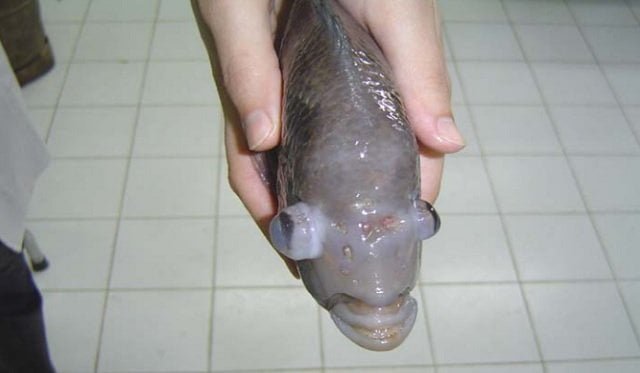
Infectious Spleen and Kidney Necrosis Virus (ISKNV)
Although not a common disease, the study by Raj et al. (2024) confirms that the Infectious Spleen and Kidney Necrosis Virus (ISKNV) is the primary pathogen responsible for disease outbreaks with high morbidity and mortality on Oscar fish farms in Kerala, India. Affected fish exhibited various clinical signs, including abnormal swimming behavior, lethargy, excess skin mucus, damaged fins, scale loss, and cutaneous hemorrhages. During necropsy, researchers observed an enlargement of the kidney and spleen.
Edwardsiellosis
Edwardsiellosis is a disease caused by the bacterium Edwardsiella tarda and affects many fish species. Although no outbreaks of this disease have been reported on Oscar fish farms, Vishnupriya et al. (2024) reported the first laboratory challenge study of A. ocellatus infected with E. tarda, which resulted in 100% mortality.
Compatibility with other fish
The Oscar fish is intelligent and curious. It is very active and territorial, especially during the breeding season. It can be aggressive towards other fish, especially those of the same species. However, it can also be a very social fish and form bonds with its tank mates.
Some suitable tank mates for Oscar fish include large cichlids, such as Jack Dempseys, Firemouths, or Severums. Species of catfish like Plecos or larger Corydoras can also coexist peacefully with Oscars. However, it is important to monitor their behavior and be prepared to separate any aggressive or incompatible tank mates.
Tips for keeping Oscar fish healthy
To ensure the well-being of your Oscar fish, consider the following tips:
- Provide ample space: Oscars require plenty of space to swim and explore. A larger tank will help reduce stress and promote overall health.
- Maintain water quality: Test water parameters periodically and perform partial water changes to keep the tank clean and water quality optimal.
- Offer a varied diet: Provide a balanced diet that includes both protein-rich foods and plant-based options to meet their nutritional needs.
- Stimulate their environment: Add decorations, hiding spots, and toys to keep your Oscars entertained and engaged.
- Monitor behavior and health: Periodically observe your Oscars for any signs of illness or abnormal behavior. Take immediate action if any issues arise.
- Avoid aggressive tank mates: Choose compatible tank mates that are similar in size and temperament to avoid conflicts and stress.
Where to buy Oscar fish and supplies
Oscar fish can be found at various pet stores, both online and offline. It’s important to choose a reputable supplier that provides healthy, well-cared-for fish. Look for stores with knowledgeable staff and a wide range of fishing supplies.
When purchasing Oscar fish, consider their size, color, and overall health. Healthy Oscars should have bright colors, clear eyes, and active behavior. Ensure the store has proper acclimation procedures to minimize stress during transportation.
In addition to fish, you’ll also need to purchase the right supplies, such as a suitable tank, filtration system, heater, and decorations. Research the specific requirements of Oscar fish and invest in high-quality equipment to provide the best possible environment for your new aquatic beauties.
The Oscar fish as an invasive species: An aquarist’s responsibility
It is crucial to address a fundamental aspect of keeping Oscars: ecological responsibility. Native to the Amazon basin, the Oscar fish’s popularity has led to its introduction into non-native ecosystems worldwide, including Florida (USA), Australia, and China.
In many of these regions, it has become a high-risk invasive species. Its large size, voracious appetite, and remarkable adaptability allow it to outcompete native species for food and spawning sites, causing a significant ecological imbalance. Furthermore, Oscars can introduce parasites and diseases that devastate local wildlife.
Under no circumstances should an Oscar fish ever be released into rivers, lakes, or any natural body of water. This action is environmentally destructive and is illegal in many countries, subject to legal penalties. If you can no longer care for your fish, please contact a local aquarium, a pet store, or another hobbyist who can properly rehome it.
Conclusion
The Oscar fish is a fascinating and attractive fish that can be a great addition to a freshwater aquarium. However, it’s important to note that it requires a large tank, specific care, and a varied diet. If you’re thinking of acquiring an Oscar fish, make sure you’re prepared to provide the care it needs.
On the other hand, if you’re thinking of breeding your Oscar fish in a community tank, you should consider compatible fish to avoid unwanted surprises. Also, make sure to continuously provide and monitor water quality to ensure the well-being of your fish and reduce the risk of disease.
Oscar Fish Frequently Asked Questions (FAQ)
What size aquarium does an Oscar fish need?
For a single adult Oscar, an aquarium with a minimum capacity of 55 gallons (approx. 200 liters) is recommended. If you plan to keep a pair, you will need a tank of 75 gallons (approx. 300 liters) or more to provide them with enough space and reduce territorial aggression.
What do Oscar fish eat?
They are omnivores with a carnivorous tendency. Their diet should be varied, using high-quality cichlid pellets as a base. This should be regularly supplemented with live or frozen foods like shrimp and worms, as well as some chopped vegetables to ensure complete nutrition.
Can I keep an Oscar fish with other fish?
Yes, but with caution. Tank mates should be of a similar or larger size and have a robust temperament. Good options include other large cichlids like the Jack Dempsey or Severum, and large bottom-dwellers like Plecos. Small fish will be seen as food.
How can I tell if my Oscar fish is male or female?
It is very difficult to distinguish them visually as they do not show clear sexual dimorphism. Males may grow slightly larger and be more colorful, but the most reliable way to know is to observe their behavior in a group and wait for a pair to form naturally for breeding.
Why does my Oscar uproot and move plants and decorations?
This is a natural behavior for the species. They are strong, curious, and intelligent fish that enjoy digging in the substrate and rearranging their environment. For this reason, it is recommended to use artificial, floating, or very durable plants, and to ensure that large rocks and driftwood are securely anchored to prevent injury.
What are the ideal water parameters for an Oscar fish?
Although they are hardy fish, they thrive under the following conditions:
- Temperature: 22-27 °C (72-81 °F)
- pH: 6.0 – 8.0
- Hardness (GH): 5 – 15 dGH
What is “Hole-in-the-Head” disease (Hexamita)?
This is one of the most common diseases in Oscars, also known as Hexamita. It manifests as small lesions or pits on the fish’s head and lateral line. It is generally caused by a combination of poor water quality, chronic stress, or nutritional deficiencies.
References
Carvalho, A. F. S., Martins, M. S. A., Paiva, I. M., Souza, J. G. S., Peconick, A. P., Baanante, I. V., Metón, I., Carneiro, W. F., & Murgas, L. D. S. (2025). Characterization of foxl2, sox9, and wt1a genes and their expression pattern as putative targets for sex identification in Astronotus ocellatus (Agassiz, 1831). Anais Veterinária e Saúde, 30(3), 1. https://doi.org/10.5380/avs.v30i3.98358
Castro-Castellón, A. E., Castro-Mejía, G., Castro-Mejía, J., Monroy-Dosta, M. C., & Martínez-Meingüer, A. M. (2020). Determination of weight and length gain of Astronotus ocellatus (Agassiz, 1831) in a biofloc system with a pigment-rich diet. International Journal of Fisheries and Aquic Studies, 8, 200-204.
Dopeikar, H., Khoshkholgh, M., Qasemi, S. A., & Morshedi, V. (2021). The effect of tank color on growth index, hematological parameters and physiological responses of Oscar fish (Astronotus ocellatus Agassiz, 1831).
Dopeikar Hakimeh, Majidreza Khoshkholgh, Seyed Ahmad Ghasemi, Vahid Morshedi, “Effects of Background Color on Growth, Stress, Biochemical, Hematological, and Immunological Responses, and Expression of Growth-Related Genes in Oscar Fish (Astronotus ocellatus)“, Aquaculture Research, vol. 2024, Article ID 6957201, 10 pages, 2024. https://doi.org/10.1155/2024/6957201
Esmaeili, N., Zare, M., Choupani, S. M. H., Kazempour, M., Hosseini, H., Akhavan, S. R., & Salini, M. (2025). Responses of oscar (Astronotus ocellatus) to different temperatures and its interaction with early mild stress. Aquaculture, 594, 741454. https://doi.org/10.1016/j.aquaculture.2024.741454
Hasaninia, A., Roudari, H. V., Khara, H., Masouleh, A. S., & Ahmadnezhad, M. (2022). Effect of dietary Lactococcus lactis and Bacillus subtilis on the innate immunity, intestinal microbiota, histometrical indices, and resistance against Aeromonas hydrophila in Oscar, Astronotus ocellatus Agassiz, 1831. International Journal of Aquatic Biology, 10(6), 438-450.
Hoseinifar, S. H., Khalili, M., & Sun, Y. Z. (2016). Intestinal histomorphology, autochthonous microbiota and growth performance of the oscar (Astronotus ocellatus Agassiz, 1831) following dietary administration of xylooligosaccharide. Journal of Applied Ichthyology, 32(6), 1137-1141.
Khade, S. T., Lokhande, P. C., Sharangdhar, M. T., Kolekar, A. D., Gitte, M. J., Sharangdhar, S. T., … & Sharangdhar, A. M. (2018). Effect of different feeds on growth performance of juveniles Oscar, Astronotus ocellatus. Journal of Experimental Zoology India, 21(2).
Mansur, V. F. R., Melo, N., Di Chiacchio, I. M., de Lima Assis, I., Machado, G. J., Paiva, I. M., … & Murgas, L. D. S. (2021). Sex identification of the ornamental amazon fish Astronotus ocellatus by videoceloscopy and gonadal biopsy. Animal Reproduction Science, 230, 106780.
Mohammadiazarm, H., Maniat, M., Ghorbanijezeh, K., & Ghotbeddin, N. (2021). Effects of spirulina powder (Spirulina platensis) as a dietary additive on Oscar fish, Astronotus ocellatus: Assessing growth performance, body composition, digestive enzyme activity, immune‐biochemical parameters, blood indices and total pigmentation. Aquaculture nutrition, 27(1), 252-260.
Paes, M. D. C. F., Makino, L. C., Vasquez, L. A., Fernandes, J. B. K., & Nakaghi, L. S. O. (2012). Early development of Astronotus ocellatus under stereomicroscopy and scanning electron microscopy. Zygote, 20(3), 269-276.
Peyghan, R., Boloki, A., & GHORBANPOUR, M. (2010). Case report and treatment of hole in the head in oscar, Astronotus ocellatus.
Raj, N. S., Sudhagar, A., Raja Swaminathan, T., Pazhur Mohandas, S., Sood, N., Pradhan, P. K., … Sarkar, U. K. (2024). Unveiling the ISKNV menace: Disease outbreak investigations in the Oscar fish (Astronotus ocellatus) farms of Kerala, India. JOURNAL OF AQUACULTURE, 33(1), 79–93. https://doi.org/10.61885/joa.v33.2024.302
Rocha, E. L. B. (2025). Aspectos morfofuncionais e biotecnológicos aplicados à reprodução de Astronotus ocellatus (Agassiz, 1831) [Tese de doutorado, Universidade Federal Rural do Semi-Árido].
Saghaei, A., Ghotbeddin, N., & Ghatrami, E. R. (2015). Evaluation of growth performance and body composition of Oscar fish (Astronotus ocellatus) in response to the consumption of dietary intake of garlic (Allium sativum). Aquaculture, Aquarium, Conservation & Legislation, 8(4), 485-490.
Taati, R. (2025). Comparison of the effectiveness of the combined diet of concentrated food with gammarus, bloodworm and mixed (gammarus and bloodworm) on growth performance, survival rate, and skin color of white Oscar fish (Astronotus ocellatus). Journal of Animal Environment, 17(2), 79-86. https://doi.org/10.22034/AEJ.2024.451267.3119
Vishnupriya, V., Swaminathan, T.R., Dharmarathnam, A. et al. Virulent and Multi-drug-Resistant Edwardsiella tarda Infection in Oscar Fish: Unveiling the Threat of Mass Mortality and AMR Dissemination. Curr Microbiol 81, 174 (2024). https://doi.org/10.1007/s00284-024-03698-6
Wang, Q., Zhang, Y. S., Peng, Q. L., Wen, B., Gao, J. Z., & Chen, Z. Z. (2022). Distinct skin morphological and transcriptomic profiles between wild and albino Oscar Astronotus ocellatus. Comparative Biochemistry and Physiology Part D: Genomics and Proteomics, 41, 100944.
Zare, M., Esmaeili, N., Hosseini, H., Choupani, S. M. H., Akhavan, S., Salini, M., … & Stejskal, V. (2024a). Do optimum dietary protein and early mild stress events prepare oscar (Astronotus ocellatus) for a stressful future?. Aquaculture Reports, 34, 101854.
Zare, M., Kazempour, M., Hosseini Choupani, S.M. et al. The crosstalk between photoperiod and early mild stress on juvenile oscar (Astronotus ocellatus) after acute stress. Fish Physiol Biochem 50, 1025–1046 (2024b). https://doi.org/10.1007/s10695-024-01316-7
Editor at the digital magazine AquaHoy. He holds a degree in Aquaculture Biology from the National University of Santa (UNS) and a Master’s degree in Science and Innovation Management from the Polytechnic University of Valencia, with postgraduate diplomas in Business Innovation and Innovation Management. He possesses extensive experience in the aquaculture and fisheries sector, having led the Fisheries Innovation Unit of the National Program for Innovation in Fisheries and Aquaculture (PNIPA). He has served as a senior consultant in technology watch, an innovation project formulator and advisor, and a lecturer at UNS. He is a member of the Peruvian College of Biologists and was recognized by the World Aquaculture Society (WAS) in 2016 for his contribution to aquaculture.
